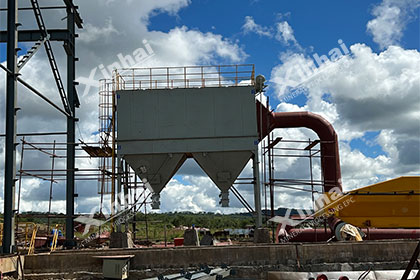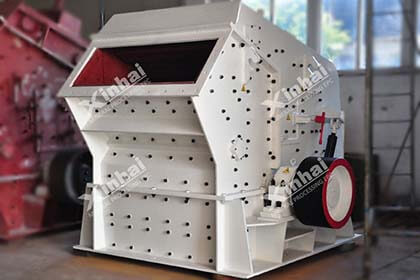Factors Affecting Screening Efficiency
 Essow
Essow
 Dec 28, 2022
Dec 28, 2022
 5133
5133
If you want to know more details about equipment, solutions, etc, please click the button below for free consultation, or leave your requirements!
Screening equipment is a commonly used equipment in mineral processing plants, which is used to screen materials before and after crushing. So what affects the efficiency of screening? How should we choose the most suitable and efficient screening equipment? Below we will talk about it from three aspects.
01 The First Type of Influencing Factor - the Nature of the Material
Back1. The Particle Size Characteristics of the Material
The particle size composition of the material to be sieved has a decisive impact on the screening process.
In the screening practice, it can be seen that the smaller the particle than the sieve hole, the easier it is to pass through the sieve hole. Particles as large as three-quarters of the sieve hole, although smaller than the size of the sieve hole, but it is difficult to pass through the sieve. Particles with a diameter slightly larger than the sieve hole often cover the sieve and prevent fine particles from passing through.
The material layer formed by particles with a diameter of 1 to 1.5 times the mesh size is not easy to allow " hard-to-sieve particles " to pass through. However, the material layer formed by particles with a diameter of more than 1.5 times the mesh size has little effect on the " easy-to-sieve particles" or " hard-to-sieve particles " passing through it to approach the sieve surface.
Therefore, the particles in the material have three particle size boundaries worth noting:
Particles smaller than three quarters of the sieve size are called "easy-to-sieve particles
Particles smaller than the sieve size but larger than three-quarters of the sieve size are called "hard-to-sieve particles
Particles with a particle size of 1-1.5 times the mesh size are called "obstructing particles".
Obviously, containing "easy-to-sieve particles" the more, the better the material sieved. Therefore, when the content of "easy-to-sieve particles" in the material is increased, the productivity of the sieve increases rapidly, or in other words, a higher screening efficiency can be obtained while maintaining a certain productivity.
The reason is that when the material with a large content of "easy-to-sieve particles" is fed to the sieve, the fine particles can easily pass through the sieve holes quickly, and the amount of material left on the sieve is reduced. At this time, even if there are still some "hard-to-sieve particles”, because the influence of other particles on them is relatively reduced, so it is also beneficial for some "hard-to-sieve particles" to pass through the sieve holes.
On the contrary, when the raw material contains more "hard-to-sieve particles" and "obstructing particles", because they prevent fine particles from contacting with the sieve surface and passing through the sieve holes, the screening efficiency will decrease.
When the content of fine grades in raw materials is small, and the materials on the sieve itself is too coarse, and its particle size greatly exceeds the size of the sieve hole, the method of adding an auxiliary sieving can be adopted.
Auxiliary sieve with larger hole size can be used to pre-discharge the over-coarse material on the sieve, and then use screen to sieve the finer material containing a large number of fine levels. Under the conditions of such two screenings, the screening efficiency can be improved and the service life of the screen can be extended.
We have an article about 5 Types of Mineral Screening Operations, includes introduction of auxiliary screen, please click the link to check it!
There is no clear regulation on the proportional relationship between the maximum allowable size of material particles and the size of the sieve hole. It is generally believed that the maximum particle size should not be greater than 2.5-4 times the size of the sieve hole.
When accurately calculating the productivity of the vibrating screen, it is necessary to determine the content of particles smaller than half the mesh size and particles larger than the mesh size in the ore feed. Because they affect both productivity and screening efficiency.
2. The Water Content and Mud Content of the Material
There are two kinds of moisture contained in the material, one is called external moisture, which is located on the surface of the particles; the other is called internal moisture, which is located in the pores and cracks of the material. The latter has no effect on the sieving process.
The surface moisture contained in the material increases to a certain extent, and the viscosity also increases. The surface moisture of the material can make the fine particles stick to each other and adhere to the large particles, and the viscous material will block the sieve holes. These reasons make the screening process more difficult, and the screening efficiency will be greatly reduced.
If the same material with the same water content is sieved by sieves with different meshes, the influence of water on the sieving efficiency is different.
The larger the mesh size, the smaller the effect of moisture. This is because the larger the mesh size, the less likely the mesh will become clogged. In addition, the more important reason is that the distribution of moisture in each particle size is uneven, and the smaller the particle size, the higher the moisture content.Therefore, when the sieve hole is large, the fine-grained grade with high moisture content can be screened out quickly, and the moisture content of the material on the sieve is greatly reduced, so that it will not affect the screening process.
Therefore, when the water content of the material is high, which seriously affects the screening process, the method of appropriately increasing the screen hole can be considered to improve the screening efficiency.
If the material contains viscous substances that are easy to agglomerate (such as clay, etc.), even when there is little water, it will be agglomerated, making the fine mud mixed into the product on the sieve, and it will also quickly block the sieve hole.
When screening viscous ores, effective measures must be taken to strengthen the screening process, such as wet screening, or pre-washing before screening to remove mud.
3. The Particle Shape of the Material
If the material particles are round, it is easier to pass through square and round holes.
Most of the crushed products are polygonal, and it is not as easy to pass through square and round holes as through rectangular holes.
It is difficult for strip, plate and sheet materials to pass through square and round holes, but it is easier to pass through rectangular holes.
02 The Second Type of Influencing Factors - the Type of Screen Surface and Working Parameters
Back1. Types of Sieve Surface
There are usually three types of working surfaces for sieves, those made of steel rods, those made of steel wire and those made of punched steel plates. Their influence on screening efficiency is mainly related to their effective area.
Type of Screen Surface | Rod Screen | Steel Plate Punching Screen | Wire Mesh Screen |
Effective Area | Least | Second Less | Large |
Service Life | Longest | Second Longest | Shortest |
Price | Lowest | Second Lowest | Most Expensive |
The larger the effective area of the sieve surface, the more the area occupied by the sieve hole, the easier the mineral particles pass through the sieve hole, the higher the screening efficiency, but the shorter the service life.
What kind of screen surface to choose should be considered in combination with the actual situation. When serious wear and tear becomes the main contradiction, wear-resistant rod screen or steel plate punching screen should be used; when fine screening is required, wire mesh screen should be used.
2. Sieve Hole Shape
The choice of sieve hole shape depends on the requirements for the particle size of the sieved product and the production capacity of the sieve. Compared with sieve holes of other shapes, circular sieve holes have a smaller particle size under the condition of the same nominal size. It is generally believed that the maximum particle size of the particles that actually pass through a circular sieve is only 80-85% of the particles that pass through a square sieve of the same size on average.
The sieve surface with rectangular sieve holes has a larger effective area and higher production capacity; when processing materials with a lot of water, it can reduce the clogging of the sieve surface. Its disadvantage is that it is easy to make strips and flakes pass through the sieve holes, which makes the under-sieve products uneven. Therefore, when it is required that the sieve does not contain fine powder, the sieve allows strip and flake particles, the material is wet and sticky and easy to cause blockage, as well as the hope that more products under the screen, etc., the use of rectangular screen hole is more favorable.
When selecting the type of sieve hole, it is best to match the shape of the material. For example, square sieve holes should be used for processing block materials, and rectangular sieve holes should be used for plate materials.
3. Sieve Hole Size
The larger the sieve hole, the higher the productivity per unit screen area and the better the screening efficiency, but the size of the sieve hole depends on the purpose and requirements of sieving.
If it is desired that the sieve product contains as few fine particles as possible smaller than the sieve hole, a larger sieve hole should be used; on the contrary, if the sieve product is required to contain as little particles as possible larger than the specified size, the sieve hole should not be too large, so that the particle size is specified as the limit for the mesh width.
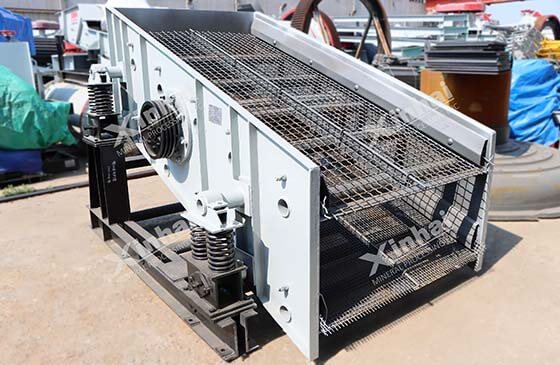
(Screen with Large Holes)
4. Movement Status of the Sieve
Although the quality of sieving is firstly determined by the properties of the material to be sieved, different effects can be obtained by sieving the same material with different types of sieves.
Practical experience points out that the sieving efficiency of a fixed sieve is very low, and the sieving efficiency of a movable sieve is related to the movement mode of the sieve body.
If the sieve body is vibrating, the ore particles will be shaken on the sieve surface in a direction close to the vertical sieve hole, and the vibration frequency is high, and the screening efficiency is the best.
On the shaking screen surface, the ore particles mainly slide along the screen surface, and the shaking frequency is smaller than the vibration frequency, so the effect is worse than that of the vibrating screen.
The rotating cylindrical screen is easy to block the screen holes and the screening efficiency is low.
The screening efficiency of various sieves is roughly as follows:
Sieve Type | Fixed Rod Screen | Trommel Screen | Vibrating Screen | Vibrating Screen |
Screening Efficiency (%) | 50-60 | 60 | 70-80 | Above 90 |
Even for the same kind of sieve, its screening efficiency varies with the intensity of the movement. The movement of the sieve body can disperse the material on the sieve surface, which is beneficial for the fine particles to pass through the material layer and pass through the sieve holes, thus improving the screening efficiency.
However, the movement speed of materials along the screen surface is related to the movement intensity of the screen body. If the movement intensity of the screen surface is too large, the materials on it move faster, and the chances of mineral particles passing through the screen holes are less, and the effect is poor. If the movement intensity of the sieve surface is too small, the materials on it cannot be dispersed, and it is not conducive to fine particles passing through the sieve holes.
We have an article about Classification and Scope of Application of Vibrating Screen, please cilck the link to see details!
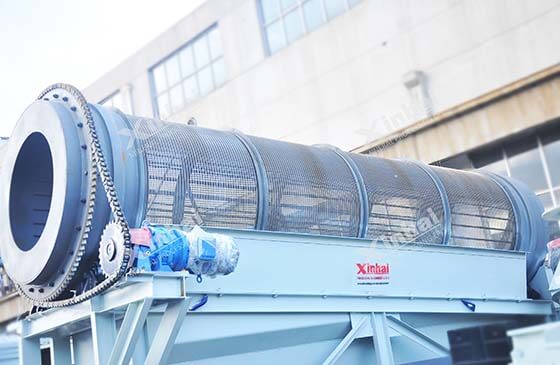
(Trommel Screen)
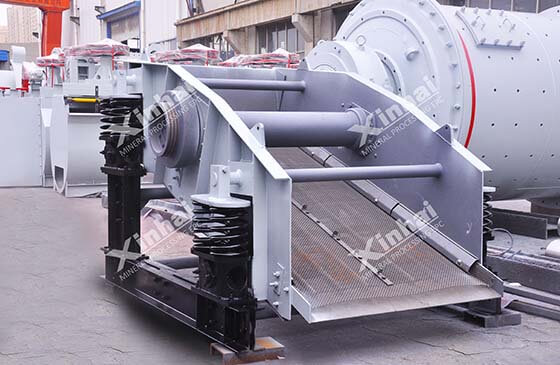
(Vibrating Screen)
5. The Length and Width of the Sieve
In the actual production, we can realize that for a certain material, the productivity mainly depends on the width of the screen surface, and the screening efficiency mainly depends on the length of the screen surface. The longer the screen surface, the longer the material is screened on the screen, and the higher the screening efficiency.
Initially, if the sieving time is slightly increased, "easy-to-sieve particles" will pass through the sieve holes in large quantities, and the sieving efficiency will increase rapidly. Later, most of the “easy-to-sieve particles” were sieved, leaving some “hard-to-sieve particles”. Although the time increased, not many of them were sieved, and the sieving efficiency did not increase much.
Therefore, it is unreasonable to sieve too long. Because when the inclination angle of the sieve surface is constant, the only way to increase the sieving time is to increase the length of the sieve surface. Too long sieve surface is not good, it wastes workshop space, the sieve structure is bulky, and the screening efficiency is not improved much, so the sieve length must be appropriate. Only when the screen works under high load, in order to ensure a high screening efficiency, if the configuration conditions permit, it is sometimes beneficial to increase the length of the screen appropriately.
The width of the screen surface must also be appropriate, and must maintain a certain proportional relationship with the length of the screen surface.
When the sieve load is equal, if the sieve width is small and the length is large, the material layer on the sieve surface would be thick, and it is difficult for fine particles to approach the sieve surface and pass through the sieve holes.
On the contrary, when the width of the sieve surface is large and the length is small, the thickness of the material layer is reduced, and the fine particles are easy to approach the sieve surface, but due to the short residence time of the particles on the sieve surface, the chances of the material passing through the sieve holes are reduced, and the screening efficiency will inevitably decrease. It is generally believed that the ratio of the width to the length of the sieve is 1:2.5-1:3.
6. The Inclination Angle of the Screen Surface
In general, the sieves are installed obliquely to facilitate the discharge of materials on the screen, but the inclination angle should be appropriate.
If the angle is too small, this purpose cannot be achieved; if the angle is too large, the material will be discharged too quickly, the time for the material to be screened will be shortened, and the screening efficiency will be low.
When the sieve surface is tilted, the area of the sieve hole that allows the particles to pass through is only equivalent to the horizontal projection of the sieve hole.
It can be seen that the greater the inclination angle of the screen surface, the greater the hindrance encountered when the ore particles pass through. Therefore, the inclination angle of the screen surface should be appropriate.
In fact, the inclination angle of the common vibrating screen in the concentrator is generally 0°-25°. The inclination angle of the fixed rod screen is generally 40°.
We have an article about 9 Considerations When Buying a Vibrating Screen, hope it can help you to choose the most suitable screen, please click the link to check it.
03 The Third Type of Influencing Factors - Operating Conditions
Back1. The Feeding should be Uniform and Continuous
Evenly and continuously feed the material into the sieve, so that the material is covered in a thin layer along the entire width of the sieve, which not only makes full use of the sieve surface, but also facilitates the fine particles to pass through the sieve holes, thus ensuring higher productivity and sieving efficiency.
2. Feeding Amount
As the feed rate increases, the production capacity increases, but the screening efficiency will gradually decrease because the screen is overloaded. When the screen is overloaded, it becomes a chute, which actually only serves to transport the material. Therefore, for screening operations, both high screening efficiency and large processing capacity are required, and one cannot be pursued one-sidedly while greatly reducing the other.
04To Wrap Up
BackThe above are the factors that affect the screening efficiency. In actual production, the appropriate screening equipment should be selected according to the nature of the material, and the amount and uniformity of the feeding should be considered.
If you need us to choose the most suitable screening equipment for you, welcome to communicate with online customer service, or leave a message to leave your needs.
 +86 182 3440 3483
+86 182 3440 3483 yanzhang19990421@gmail.com
yanzhang19990421@gmail.com




 Message
Message Chat Now
Chat Now


